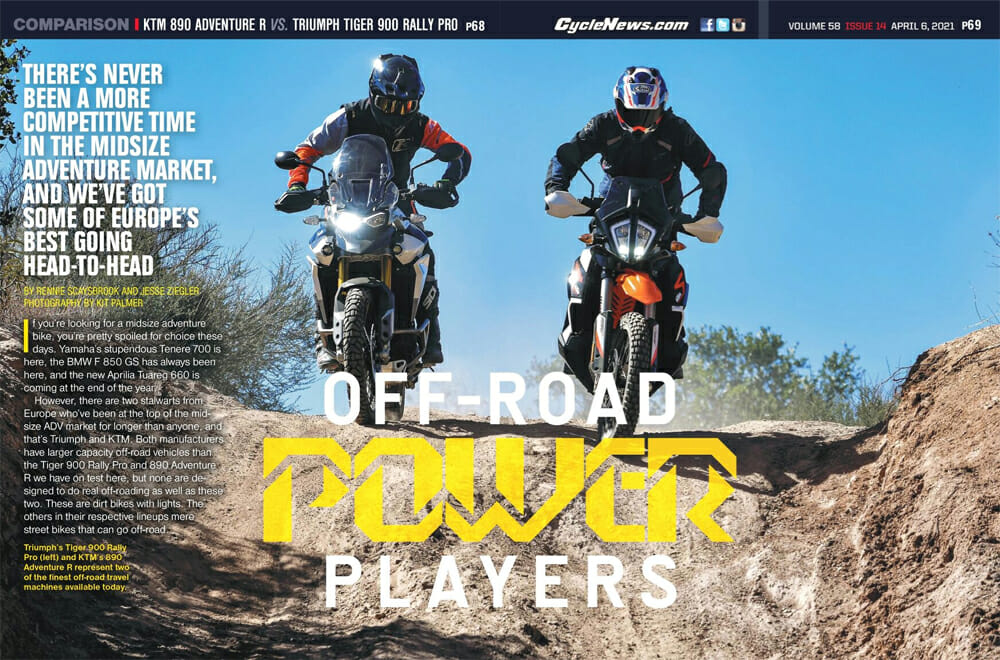Cycle News Staff | April 8, 2021
There’s never been a more competitive time in the midsize adventure market, and we’ve got some of Europe’s best going head-to-head.
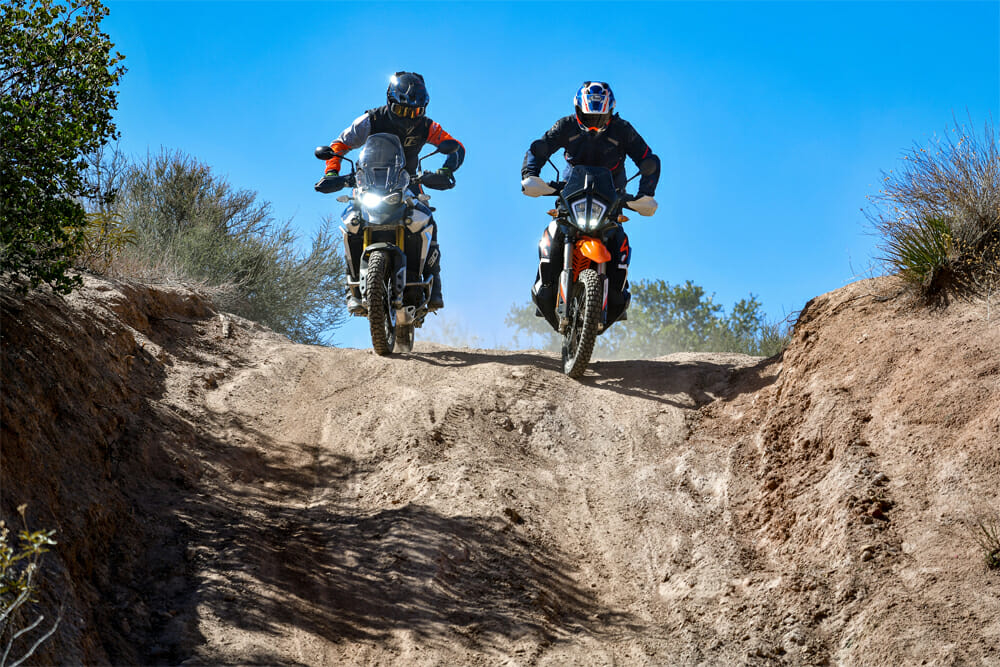 Triumph’s Tiger 900 Rally Pro (left) and KTM’s 890 Adventure R represent two of the finest off-road travel machines available today.
Triumph’s Tiger 900 Rally Pro (left) and KTM’s 890 Adventure R represent two of the finest off-road travel machines available today.
By Rennie Scaysbrook and Jesse Ziegler | Photography by Kit Palmer
If you’re looking for a midsize adventure bike, you’re pretty spoiled for choices these days. Yamaha’s stupendous Tenere 700 is here, the BMW F 850 GS has always been here, and the new Aprilia Tuareg 660 is coming at the end of the year.
However, there are two stalwarts from Europe who’ve been at the top of the midsize ADV market for longer than anyone, and that’s Triumph and KTM. Both manufacturers have larger capacity off-road vehicles than the Tiger 900 Rally Pro and 890 Adventure R we have on test here, but none are designed to do real off-roading as well as these two. These are dirt bikes with lights. The others in their respective lineups mere street bikes that can go off-road.
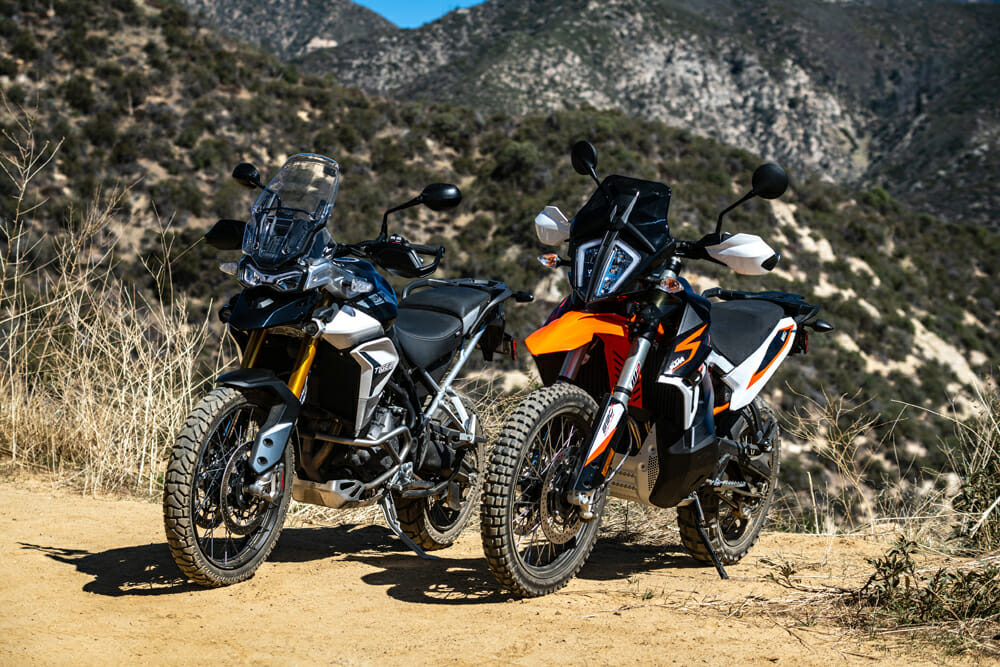
The Contenders
Triumph Tiger 900 Rally Pro
The Tiger 900 Rally Pro is the British company’s premium off-road ADV weapon and tips the financial scales at $17,100, and for that, you get everything the three other Tiger 900 models have and more.
Triumph has developed an all-new motor in the 888cc inline-three cylinder, complete with the T-plane crank, which fires at varying 1-3-2 intervals dependent on crank position to mimic the behavior of a twin at low revs while still giving the performance of a triple at high rpm.
Triumph’s T-Plane crank fires uniquely, starting with 180-degrees of rotating fire from cylinder one-to-three and then firing cylinder two 270-degrees after. Cylinder one fires again after another 270-degrees. This drops two combustions of tire-hate closer together as the crank spins to give the feeling of a twin at lower speed and rpm.
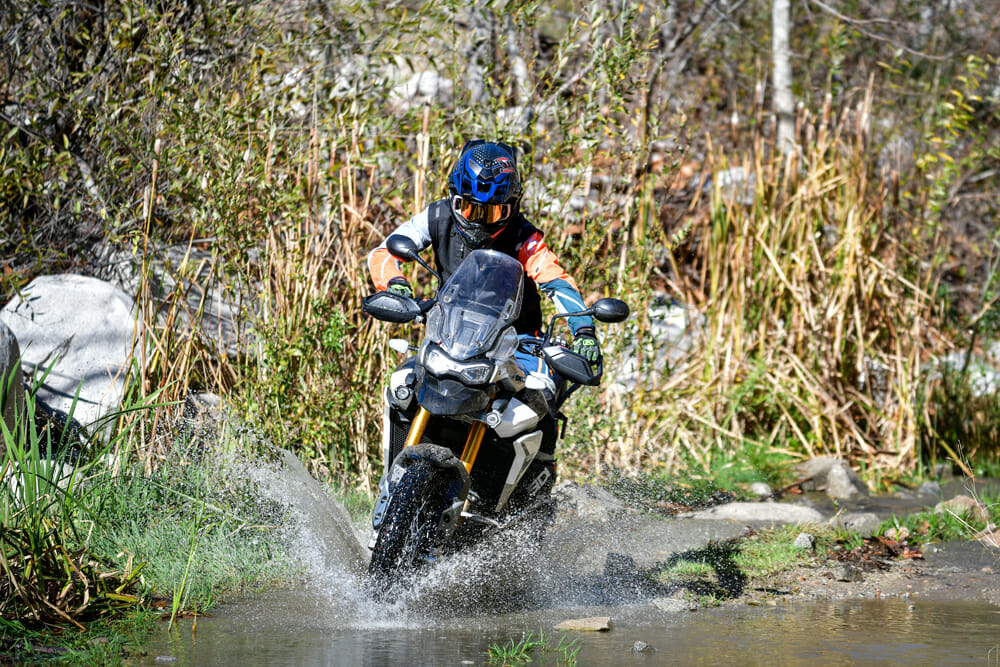 Low-speed throttle response is vastly improved on the Triumph with the T-plane crank.
Low-speed throttle response is vastly improved on the Triumph with the T-plane crank.
In all, there’s a 10-percent increase in torque from the Tiger’s previous life as an 800, with Triumph claiming 64 lb-ft at 7250 rpm. Peak power comes 1500-rpm higher at 8750 rpm for 93 horsepower matched to an up and down quickshifter-assisted six-speed gearbox, and, over three days and 500-plus miles of riding, we averaged 48.32 mpg from the roaring triple, giving it a theoretical range of 256 miles per 5.3-gallon tank.
Running a tubular steel chassis and subframe, the Tiger certainly has the bones to get well off the beaten path, and you can beat it back into rideable shape if you crash in the middle of nowhere. Triumph runs with Showa suspension for the Rally Pro, with 9.4-inches of wheel travel coming from a front end that consists of 45mm forks, fully adjustable for preload, rebound and compression. At the rear, Showa’s monoshock doesn’t come with full adjustment, offering preload and rebound with nine inches of wheel travel. Seat height is variable, with 33.5-inches as the base height and 34.3-inches on the high side.
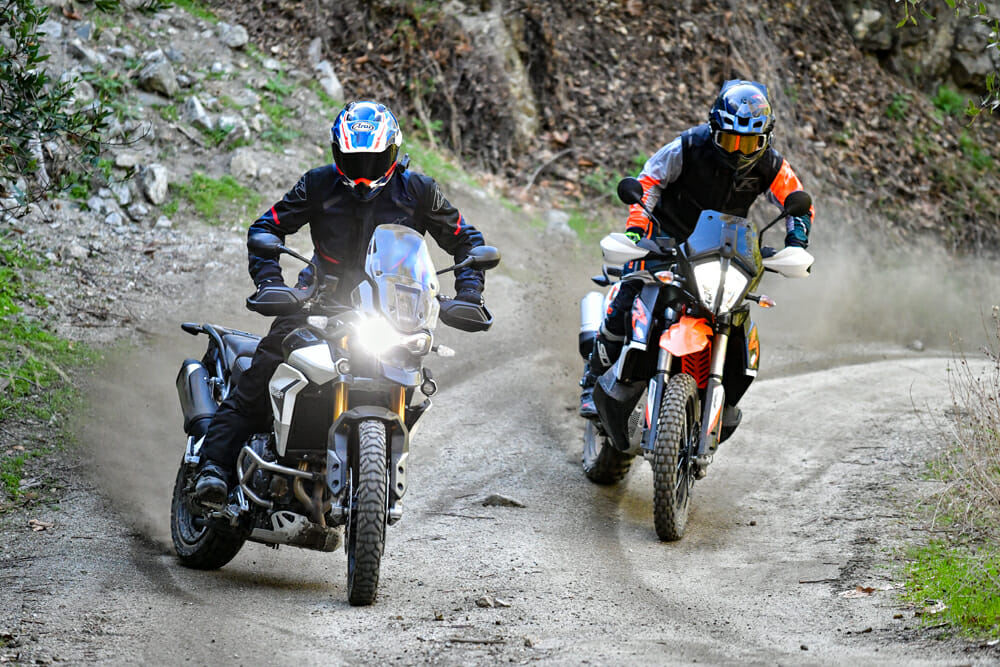 The Triumph has a slightly longer wheelbase than the KTM and is plenty stable for throwing the back end out like this.
The Triumph has a slightly longer wheelbase than the KTM and is plenty stable for throwing the back end out like this.
Brakes come in the form of dual superbike-spec Brembo Stylema four-piston units gripping 320mm discs up front with a single-piston caliper clamping a 255mm disc at the back, both ends feted by Cornering ABS.
Tubeless spoked wheels measure 21-inches on the front and 17-inches on the rear and are wrapped in Pirelli Scorpion rubber as standard but were strangely fitted by Triumph North America with Dunlop Trailmax Mission dual-sport rubber for our test.
Running a full 5.3-gallon tank of gas, we measured the Triumph at 505 pounds on the Cycle News scales (quoted dry weight, the world’s most useless measurement, is 443 pounds from Triumph).
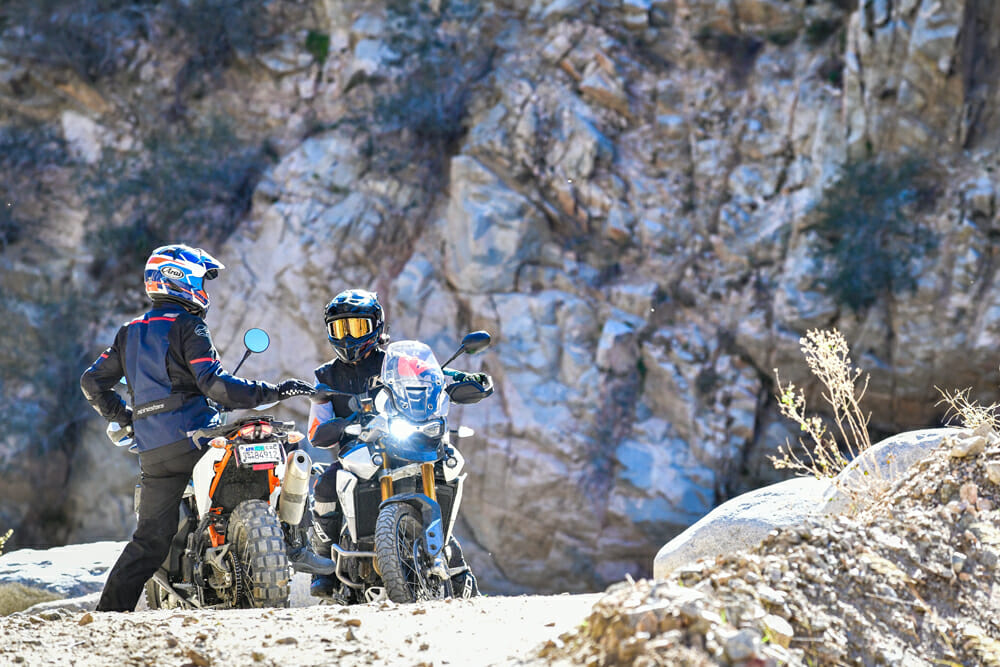 The limit for where these things can go is almost entirely up to the riders.
The limit for where these things can go is almost entirely up to the riders.
The Continental IMU-guided electronics are aplenty in the Rally Pro. Cruise control, Cornering ABS and traction control come stock, with the latter an on/off arrangement compared to the nine-level adjustable unit on the KTM in Rally mode. There’re a whopping six riding modes to play with—Road, Rain, Sport, Off-Road (where rear ABS is disabled), Off-Road Pro and Rider Programmable—all offering their own levels of throttle intervention with no bearing on suspension performance as that is a purely analog situation.
Going Pro gives you the full suite Triumph Connectivity System for the 7-inch TFT dash, Triumph Shift Assist (quickshift), illuminated switchgear on the handlebar, LED fog lights, centerstand, tire-pressure monitoring, engine-protection bars, aluminum skid plate, heated rider and passenger seats, and the Rider Programmable Mode.
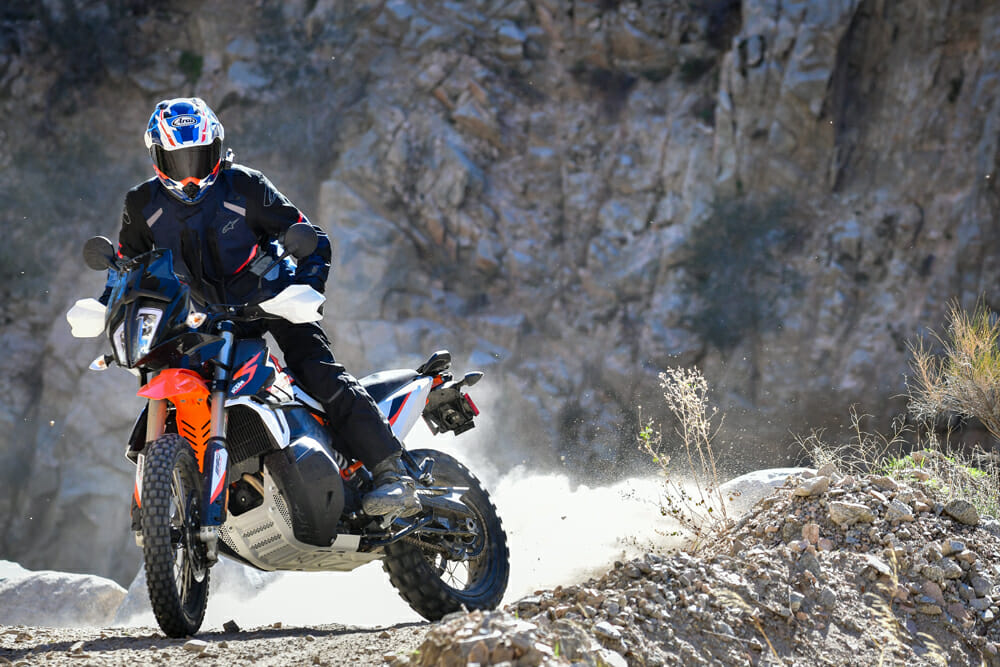 The KTM is basically a massive dirt bike, and this kind of carrying on is child’s play.
The KTM is basically a massive dirt bike, and this kind of carrying on is child’s play.
KTM 890 Adventure R
The KTM 890 Adventure R comes in at a $14,199 base price. You’ve got to add an extra $500 for the Rally pack (not to mention the taxes and dealer fees) that we had fitted to our test bike. This gets you the Rally riding mode, nine-level traction control and different throttle maps.
Running a six-axis IMU, the KTM’s Rally mode pairs with the standard modes of Street, Rain, and Off-Road, all with varying traction-control-slip and throttle-response levels. In the first three modes, the KTM’s Motorcycle Traction Control (MTC) system is like the Triumph’s in that it is either on or off, so if you want more control over your rear-wheel slip, you’ve got to go the Rally mode.
Once you get into the Off-Road mode, you switch off the ABS for the rear, although, like the Triumph, ABS is always working on the front as per Euro 5 laws. Off-Road also allows you to switch off wheelie control, enabling you to get over rocks and logs without feeling like the motor is about to have an electronic cardiac arrest.
KTM’s 890 Adventure R grew from 799cc to 889cc for 2021 and beyond, not for any other reason than to get the emissions coppers off its back. More capacity means more torque, so it was a win/win for KTM even though the 890 can no longer be considered (the same for the Triumph, for that matter) to be a true middleweight machine.
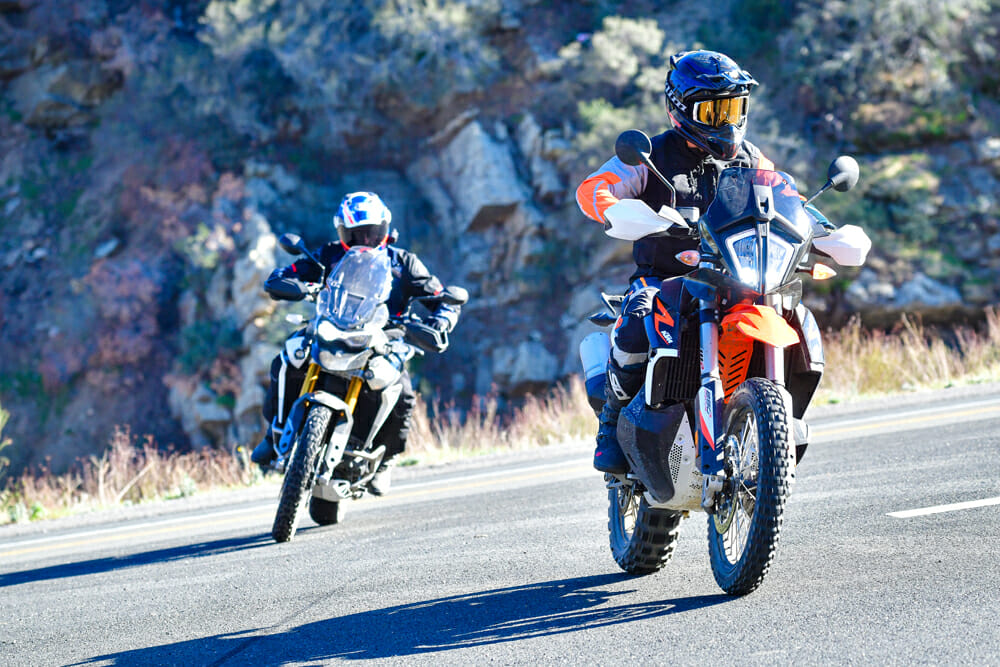 More dirt-bike-based ergos mean the KTM isn’t quite as comfy as the Triumph on the road.
More dirt-bike-based ergos mean the KTM isn’t quite as comfy as the Triumph on the road.
The new motor isn’t just a case of boring out the old one. There’s a 20-percent heavier flywheel for more controlled torque delivery, and it gets running changes such as additional oil jets to cool pistons, new connecting rods and pins, a revised clutch assembly with new friction plates and more cooling.
Matched to KTM’s up-and-down quickshifter and six-speed gearbox, KTM’s 890 makes a claimed 100 horsepower taken at 8000 rpm and 74 lb-ft of torque at 6500 rpm. Over our three days of testing, we got an average of 43.6 mpg for the 890, giving a theoretical range of 230-odd miles per 5.3-gallon tank.
KTM’s laced the 890 Adventure R with some sweet springers in the 48mm WP Xplor fork and shock, both fully adjustable and both with 9.4-inches of travel. Like the Triumph, the chassis and subframe is a tubular-steel design, although, unlike the Triumph, the fuel is carried down near the rider’s shins, which dramatically changes the center of gravity and how the motorcycle reacts when on a full tank. Slightly taller than the Triumph in seat height at 34.6 inches, we measured the 890 on the scales with a topped tank at 490 pounds.
Braking is taken care of by dual four-piston calipers gripping 320mm discs up front and a single-piston caliper clamping a 260mm disc at the back. Cornering ABS is standard fitment on the 890, which can be disabled on the rear when you get into the Off-Road mode. Rubber comes in the form of Continental’s TKC 80 with wheel sizes varying slightly from the Triumph in the 21-inch front and 18-inch rear.
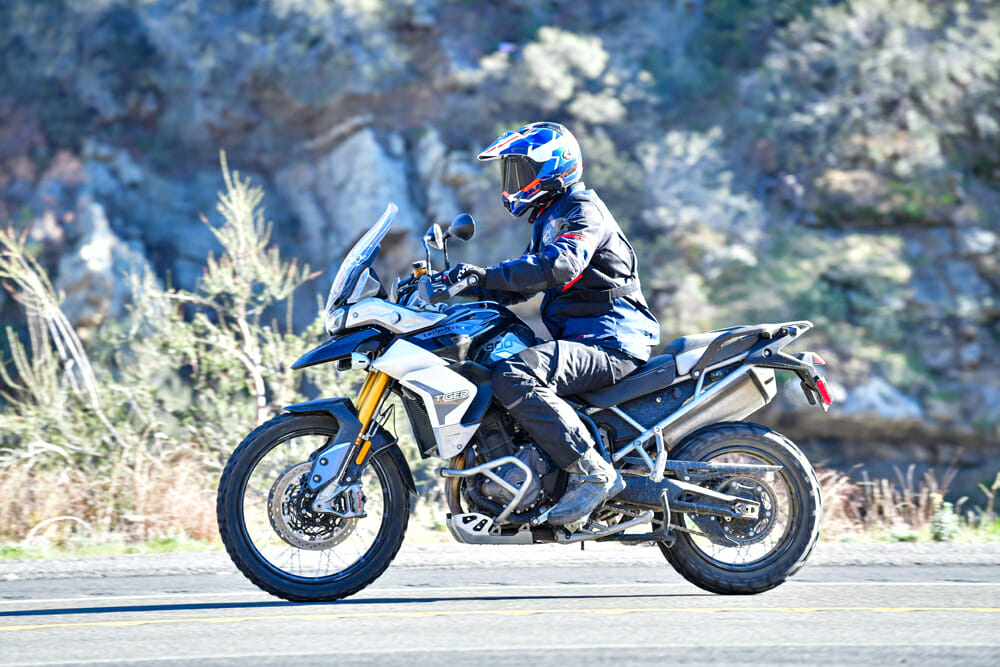 Here, you can see how Jesse and Rennie both picked the Triumph if the majority of the riding done is on the street.
Here, you can see how Jesse and Rennie both picked the Triumph if the majority of the riding done is on the street.
KTM 890 Adventure R vs. Triumph Tiger 900 Rally Pro Comparison | On-Road, Off-Road
Right. Enough of the tech talk. What are they actually like to ride? Well, bloody different is the short of it.
There’s two competing ethos here. The first is KTM’s now admittance that they aren’t building the 890 Adventure R as anything other than the best off-road travel bike they can. The Adventure R gets every concession made to it that makes it a better off-road machine, while the Triumph still has a few benefits to on-road performance while trying to match the KTM everywhere else.
Over three days and around 600 miles of testing, we found just about every condition we could think of where you’d take one of these bikes. Touring miles on freeways, commuting, dirt roads into the mountains, doing milk runs (both Jesse and I have young kids at home), we did it all on these bikes.
Where the Triumph shines is predictably on the tarmac. As a travel motorcycle, the ergonomics and especially the way the three-cylinder makes its torque gives the British machine an edge over the Austrian. Freeway jaunts are a cinch on the Triumph, although adjusting the screen to help wind deflection is a pain.
When we cross over to the dirt roads, where we hope most Rally Pro owners will venture, the Triumph begins to show its shortcomings compared to the KTM. In isolation, the Triumph is all the adventure bike you’ll need and will handle rough terrain easily—within reason. Get a little over-enthusiastic with your rock hopping or trail bashing, and you’ll quickly find the limits of the suspension. The Showas will hit the bottom of the stroke faster than either Jesse or I would have liked, making the ride not as composed as on the KTM.
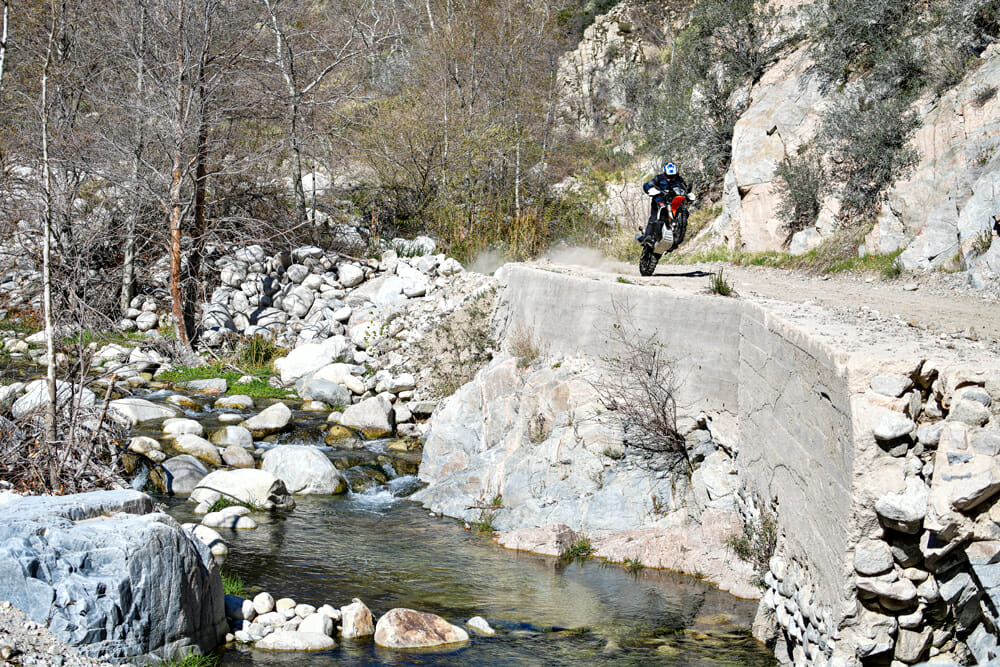 Have KTM, will wheelie.
Have KTM, will wheelie.
But it’s not just the quality of the suspension components that hurt the Triumph; it’s the overall architecture.
KTM’s development of the fuel tank straddling either side of the frame, in front of the rider’s knees, has completely changed the game in terms of how stable a big-adventure bike can be over questionable terrain. The fact of having the weight so low, compared to the Triumph’s traditional gas-tank layout, improves everything from how well the chassis rides over bumps to the stability it has under braking and how controllable the machine is when you wind the power on—and this is before we get into the electronics.
Mechanically, the KTM is better designed for real off-roading. The Triumph feels like a street bike converted to dirt purposes. This helps explain why Jesse and I would go for the Triumph if all we were doing was street touring with a touch of off-roading, which, let’s be honest, is where many adventure-bike owners actually ride.
If we delve further into the two bikes, a separator is in the electronics. While the Triumph definitely holds the edge over the KTM in the dash department, KTM’s no-frills dash philosophy—even if it’s not as pretty as the Triumph’s—is far easier to use. There’s actually more adjustability available in the KTM than the Triumph, but it’s paradoxically easier to utilize.
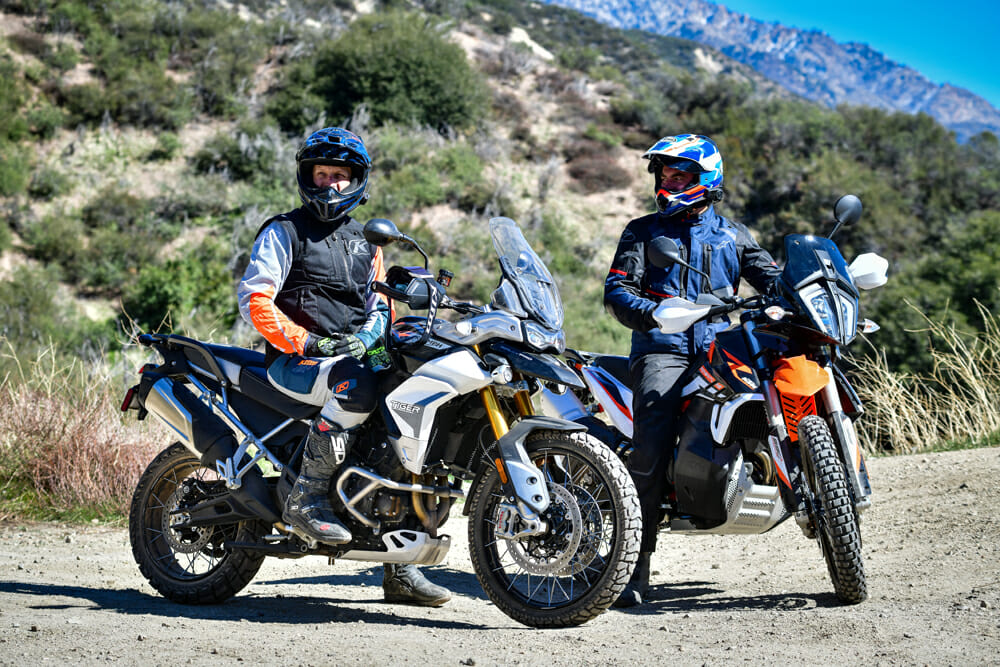 Heated seats and grips are a win for the Triumph (left).
Heated seats and grips are a win for the Triumph (left).
In practice, KTM’s suite of rider electronics is a step above the Triumph. There’s a $2500-odd difference in price here once you include the KTM’s Rally Pack, with the nine-stage traction control an absolute winner over the Triumph. To really explore what the Triumph can do off-road, you have to switch traction control off. It’s too intrusive otherwise, whereas compared to the KTM, with its nine stages, you can dial in as much or as little slip as you like and still have a safety net available.
Both machines have excellent motors. However, the KTM’s more docile power delivery at low revs is a win over the Triumph. Triumph’s new motor is a genuine step above its predecessor in terms of low-down throttle response and especially overall vibrations, but the KTM’s parallel-twin is better suited—not to mention more compact—to proper off-roading.
The Triumph is a nicer street engine, with smoother low-end torque, although the KTM pulls ahead in high-rpm horsepower. That’s less of a concern for this class, and if all you’re after is a good street bike with a touch of off-roading, go for the Triumph. It’s a more comfortable long-range ride, especially given the plank-like seat of the KTM.
The KTM is an off-road bike, pure and simple. Think of it as the father to the 500 EXC, and you get the picture. Both machines have a ton of accessories, but there’s even more of that stuff in the aftermarket, so we’re not going to concern ourselves with that here.
Considering the price, specification, ease of use, and overall performance, there’s only one winner here, and it’s painted orange.CN
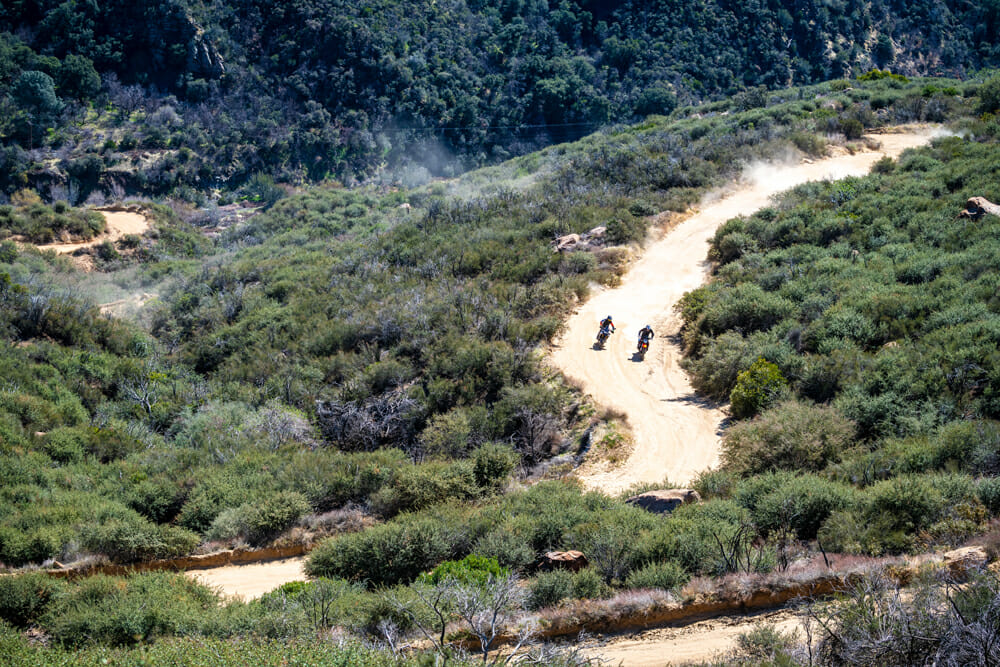 Grab your buddy and hit the hills. Either of these two will make a near-perfect ADV travel companion, but the KTM edges ahead overall.
Grab your buddy and hit the hills. Either of these two will make a near-perfect ADV travel companion, but the KTM edges ahead overall.
VIDEO | KTM 890 Adventure R vs Triumph Tiger 900 Rally Pro
Jesse’s Very Jesse-Like Opinion
I’ve had a lot of time on both of these ADV platforms. I took a pre-pandemic jaunt to Morocco to saddle up on the Triumph a year ago, and I’ve bombarded KTM 790/890s across the American West for a couple years now. They are both attractive options but being honest about where and how I enjoy riding the most, I’m always going to lean to the off-road winner. That’s the KTM here. It just has more intent built-in for how I like (imaginary or not) to ride.
An added benefit to KTM’s dirt focus is it has created a nimble, ground-hugging street machine that carves and flicks its way around the tarmac in canyons and in town. It’s born from a Duke, after all, and has a technical bias towards the street as well as dirt.
The Triumph is close. A fork-valving update would help its manners tremendously in the dirt, and its power delivery is excellent for mixed terrain. It also looks and sounds fantastic. But ergonomically, it will never match KTM’s focus for the most active riding. Its bar position and seat location are street biased for touring comfort. And you can feel that as soon as you get aggressive with handling on-road or off.
If my journeys were less technical on- or off-road, or if I trusted my friends to not explore bad ideas on the regular, I would be happy on the Triumph, easily. They really are stronger on different sides of the ADV sliding scale.
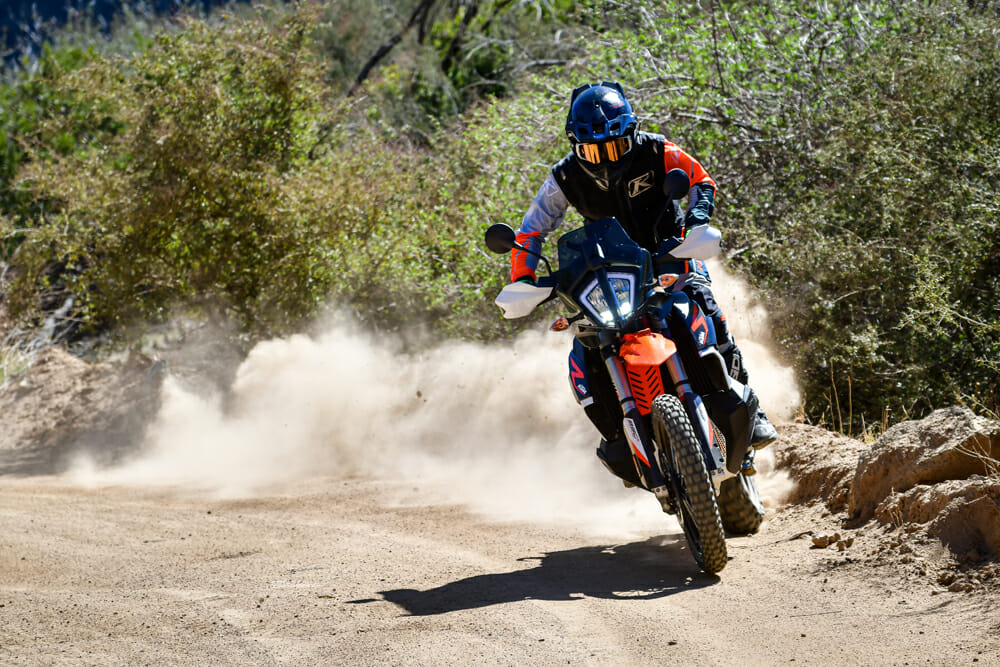
The rowdier you get, the more the KTM shines. The more touring you feel like doing, the Triumph’s comfort and performance will, well, triumph. It really is almost that simple. But what seals the deal for more buyers, in my opinion, is price.
The Tiger comes with a hefty price increase over the massively capable KTM. Yes, it has heated seats and grips and a nice place to store your phone and plenty of added value for the price. But for the cash, I could buy a lot of tires or a set of the narrower wheels that come on the Rally edition of the 890 and put a nice down payment on WP’s Pro Component suspension and turn the 890 into an absolute beast. Or, if I’m touring, I could buy capable luggage and some long-distance riding gear.
It’s my opinion that the Triumph isn’t dominant enough as a touring motorcycle to be a totally better choice based on performance. The KTM is too close there to shake the price difference.
There you go. The KTM is easier to put in the winning category across all ADV arguments except one. And that’s looks. The Triumph looks awesome. It also sounds awesome. (Did I mention it sounds awesome?) If price is not your concern and you just want the best-looking/sounding midsized ADV weapon. Go British.
2021 KTM Adventure R Specifications
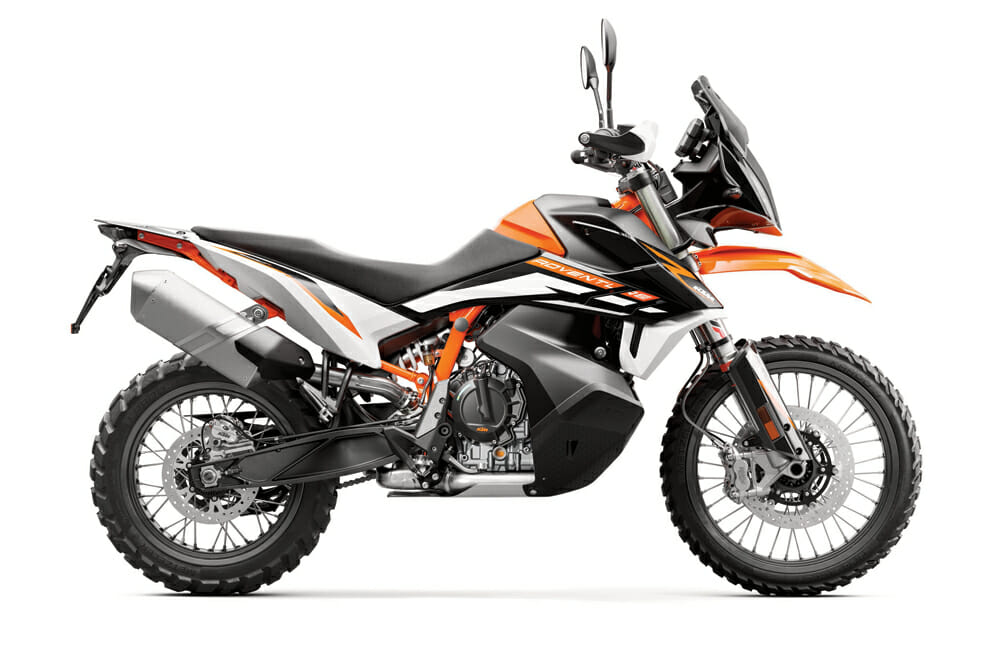
|
|
| MSRP: |
$14,199 |
| Engine: |
Parallel twin, 4-stroke |
| Valvetrain: |
DOHC, 8 valves |
| Displacement: |
889cc |
| Bore x Stroke: |
90.7 X 68.8mm |
| Cooling System: |
Liquid |
| Horsepower (claimed): |
100 hp at 8000 rpm |
| Torque: (claimed): |
74 lb-ft at 6500 rpm |
| Fueling: |
EFI Dell’Orto w/ 46mm throttle body |
| Transmission: |
6-Speed |
| Clutch: |
Pasc assist-and-slipper clutch |
| Frame: |
Chromoly Tubular Steel w/ stressed engine; chromoly trellis subframe |
| Handlebars: |
Tapered aluminum |
| Front Suspension: |
WP Xplor, fully adj. |
| Rear Suspension: |
WP Xplor, single shock, fully adj. |
| Front-Wheel Travel: |
9.4 in. |
| Rear-Wheel Travel: |
9.4 in. |
| Front Brake: |
Radially mounted 4-piston calipers, dual 320mm discs w/ ABS & cornering ABS |
| Rear Brake: |
Single 260mm disc, 2-piston floating caliper, w/ ABS & cornering ABS |
| Front Wheel/Tire: |
Spoked, 90/90-21 in. Continental TKC 80 |
| Rear Wheel/Tire: |
Spoked, 150/70-18 in. Continental TKC 80 |
| Rake: |
26.3/26.2° |
| Wheelbase: |
60.2 in. |
| Seat Height: |
34.6 in. |
| Fuel Capacity: |
5.3 gal. |
| Weight (wet, measured): |
490 lbs. |
| Fuel Consumption (measured): |
43.6 mpg (range approximately 230 miles) |
|
Triumph Tiger 900 Rally Pro Specifications
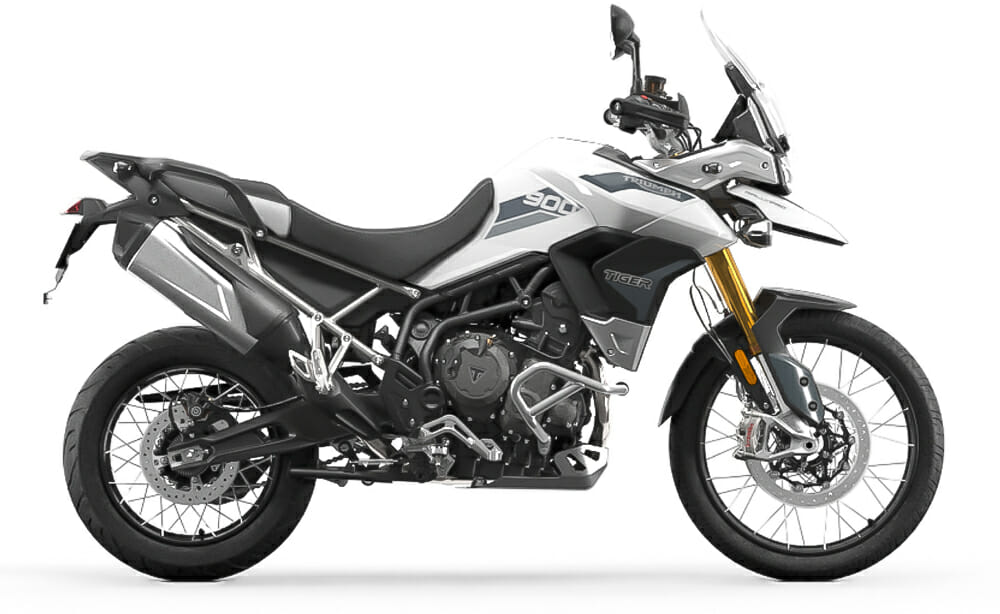
| MSRP: |
$17,100 |
| Engine: |
Inline triple, 4-stroke |
| Valvetrain: |
DOHC, 12 valves |
| Displacement: |
888cc |
| Bore x Stroke: |
78mm x 61.9mm |
| Cooling System: |
Liquid |
| Horsepower (claimed): |
95.2 hp at 8750 rpm |
| Torque (claimed): |
64.2 lb-ft at 7250 rpm |
| Fueling: |
Multipoint sequential electronic fuel injection |
| Transmission: |
6-speed |
| Clutch: |
Wet, multi-plate |
| Frame: |
Tubular steel frame, detachable subframe |
| Front Suspension: |
Showa 45mm, fully adj. |
| Rear Suspension: |
Showa, single shock, fully adj. |
| Front-Wheel Travel: |
9.4 in. |
| Rear-Wheel Travel: |
9.1 in. |
| Front Brake: |
Twin 320mm floating discs, Brembo Stylema, 4-piston Monobloc calipers, w/ ABS & cornering ABS |
| Rear Brake: |
Single 255mm disc, Brembo 1-piston sliding caliper, w/ ABS & Cornering ABS |
| Front Wheel/Tire: |
Spoked, 90/90 x 21 in. / Dunlop Trailmax Mission |
| Rear Wheel/Tire: |
Spoked, 150/70R x 17 in./ Dunlop Trailmax Mission |
| Rake: |
24.4° |
| Wheelbase: |
61 in. |
| Seat Height: |
33.5-34.3 in. |
| Fuel Capacity: |
5.3 gal. |
| Weight (wet, measured): |
505 lbs. |
| Fuel Consumption (measured): |
48.6 mpg (range approximately 256 miles) |
|
